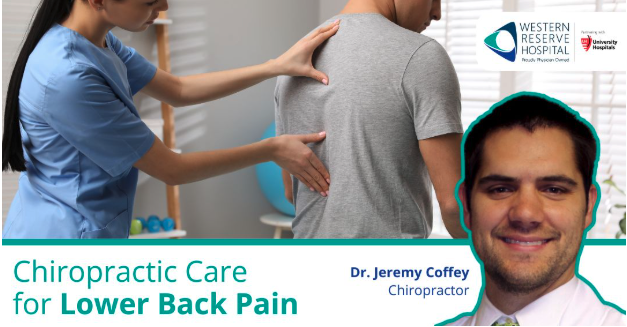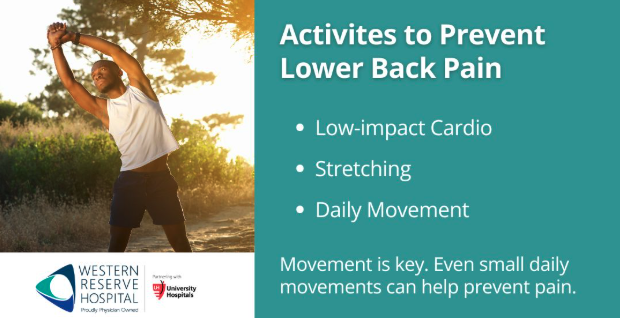
Lower back pain affects 28% of U.S. adults — nearly every 3 in 10 people — with almost half of those suffering for five years or more. For many, it’s more than an occasional ache. It limits mobility, makes standing for long periods difficult, disrupts sleep, and even takes a toll on mental health.
Chiropractic healthcare is one way to find pain relief. As a non-invasive treatment, it reduces pain, restores range of motion, and supports long-term recovery without side effects.
Dr. Jeremy Coffey, our chiropractor at Western Reserve Hospital, shares his insights on what causes lower back pain and how chiropractic care helps.
Part 1: Understanding Lower Back Pain
What Causes Lower Back Pain?
Lower back pain can occur due to many factors, from everyday activities to underlying health conditions. Common causes include:
- Improper lifting techniques (like lifting heavy objects suddenly)
- Repetitive movements (like doing the same exercise over and over)
- Poor posture
- Prolonged sitting
- Muscle or ligament strains
- Degenerative or herniated discs, joints, and ligaments
- Osteoporosis
- Excess weight
- Weak abdominal muscles
- Spinal stenosis
Falls or sudden impacts can also trigger pain, sometimes leading to muscle sprains or more serious injuries like displaced spinal discs.
But lower back pain isn’t always the result of physical injuries. “Emotional stress can also manifest as physical pain,” says Dr. Coffey. If you’re under a high level of stress, you might experience muscle tension and discomfort, which can “collect” in your lower back.
Acute vs. Chronic Lower Back Pain
When it comes to lower back pain, the length of time it persists matters. Pain that develops suddenly — whether from lifting something heavy, an awkward movement, or a minor strain — is called acute low back pain.
According to Dr. Jeremy Coffey, “Medically, acute lower back pain is something that has occurred within the last few weeks, up to a couple of months. If pain persists beyond two months, it starts to be considered chronic.”
Chronic pain lingers on. If your back has been hurting for more than two months — especially without an obvious injury — it’s no longer a short-term issue. This can happen as a result of ongoing inflammation, pinched nerves, muscle spasms, or arthritis.
How Chiropractic Treatment Helps Relieve Lower Back Pain
Misalignments in the spine, muscle tightness, and restricted movement cause discomfort and pain. Chiropractic care focuses on restoring motion and function to the lower back, which means it works on the root cause of your pain instead of improving your symptoms.
Dr. Coffey explains, “Chiropractic care helps the body ‘reboot’ by improving the motion and function of the lower back, reducing pain and irritation.” This is usually done through chiropractic adjustments, myofascial work, and traction-based treatments.
Chiropractic Techniques for Lower Back Pain
Chiropractic healthcare providers use different techniques and manual therapies to treat lower back pain, depending on the patient’s condition and how they respond to care. “Some patients respond well to traditional adjustments, while others benefit more from conservative techniques,” says Dr. Coffey.
Here’s a closer look at the three different types of chiropractic treatment options for chronic low back pain:
- Traditional adjustments (popping and cracking). Chiropractors use precise, controlled thrusts (like diversified and gonstead adjustments) to correct misalignments. These often produce the well-known “pop” as gas releases from the joints. They improve spinal health by realigning the spine, reducing stiffness, and improving mobility.
- Myofascial work (muscle-focused therapy). Some cases of lower back pain involve tight, overactive muscles and fascia (the connective tissue around muscles). Chiropractors use myofascial work to release muscle tension and restore flexibility.
- Traction-based techniques (gentle stretching of the spine). This focuses on gradual spinal decompression to relieve pressure on discs and nerves. It can be effective for sciatica, herniated discs, and degenerative disc disease.
Part 2: Chiropractic Care and Long-Term Pain Management
How Chiropractic Care Fits Into a Holistic Pain Management Plan
Pain is rarely just a physical issue. It affects how you move, how you feel, and even how you think. Holistic pain management looks at the bigger picture and recognizes that pain isn’t just about sore muscles or stiff joints.
It considers the body, mind, and overall well-being, going for lasting relief rather than just treating symptoms.
For long-term results, “A combination of approaches is often the most effective way to treat chronic pain,” says Dr. Coffey.
Here’s how chiropractic care fits into a holistic pain management plan:
- Physical therapy. Chiropractic adjustments restore joint movement, but without strong muscles to support the spine, the pain can return. That’s where physical therapy helps. A physical therapist stabilizes your muscles to prevent misalignment, improves your posture (which reduces strain on the spine), and increases flexibility. This makes everyday movement easier and pain-free.
- Massage therapy. Tight muscles pull the spine out of alignment, limit movement, and contribute to pain. Massage therapy techniques like deep tissue work relieve knots and chronic muscle tightness. They improve your flexibility and support the adjustments made by your chiropractor.
- Pain management medication. If you have severe or persistent pain, you might need anti-inflammatory medications or steroid injections. Chiropractic care doesn’t replace pain medications, but it helps you rely on them less over time.
The Importance of Spinal Alignment and Mobility
While many people focus on achieving a “straight” spine, mobility matters more. When joints don’t move as they should, muscles tighten, nerves become irritated, and function declines.
Dr. Coffey explains that when spinal mobility decreases — whether from injury, poor posture, or prolonged sitting — it disrupts the entire system. Nearby muscles tighten to compensate, nerves can become irritated, and movement patterns shift, which causes further discomfort. Over time, this cycle causes chronic pain and stiffness.
For instance, because of your lower back pain, you may not be able to stand up straight. If this continues for a long time, your spine might contract and leave you unable to lift, twist, or even walk comfortably.
Your body will adapt to this restriction, but not in a good way. Instead of keeping movement fluid, it will lock up, forcing other muscles and joints to work harder. This leads to secondary pain — for example, hip or knee discomfort that develops when the lower back isn’t functioning properly.
Chiropractic care breaks this cycle by restoring movement to restricted joints. Spinal manipulation encourages the spine to move as it should, allowing surrounding muscles to relax and relieving pressure on the nervous system. When mobility improves, the body regains balance, which reduces strain on areas forced to overcompensate.
Lifestyle Changes and Exercises to Prevent Lower Back Pain

Lower back pain often starts when movement decreases. Sitting for long periods, avoiding activity due to discomfort, or skipping basic stretching weakens the muscles that support the spine. Over time, stiffness sets in, making pain more likely.
“Movement is key [here],” says Dr. Coffey. “Even small daily movements, like standing up more frequently, can help prevent pain.” Here are some changes he recommends to keep your lower back strong and mobile:
- Low-impact cardio. Gentle, consistent movement like walking keeps your muscles and spine flexible, reduces pain levels, and reduces strain on your lower back. You could start with stationary bicycling, an elliptical trainer, or swimming to get the same benefits.
- Stretching. Stretching helps you relax tight muscles and improve flexibility, no matter your fitness level. Exercises you could try include the cat-camel, bird dog, cobra stretch, and child’s pose.
- Daily movement. Sitting for long periods is one of the most common reasons for low back pain. Try to stand up every 30 minutes if you’re working at a desk to prevent stiffness. You should also shift positions often (to relax your posture).
Common Habits and Postures That Contribute to Lower Back Pain
Daily activities — like how you stand, bend, or reach — affect the lower back more than you might realize. Muscle strain builds gradually, and most people don’t notice it until stiffness or discomfort sets in.
Some of the most common culprits include:
- Sweeping, mopping, and vacuuming
- Washing dishes
- Carrying heavy bags or purses
- Sitting too long
- Lifting incorrectly
“To prevent strain, it’s important to use good posture and take breaks when doing these activities,” says Dr. Coffey.
If you’re doing the dishes, try to keep your back straight, and when you’re sitting for long periods, stand up every few hours and stretch. These habits help prevent lower back pain and keep your overall health in good shape.
How Soon Does Chiropractic Care Relieve Lower Back Pain?
How soon you’ll get relief from lower back pain after your first visit depends on its severity and how long you’ve been struggling with it.
On average, chiropractors recommend four visits over four weeks to assess improvement. Patients with acute lower back pain see improvements faster than those with chronic pain.
“If there’s no improvement after four visits, we may need to reassess the treatment plan,” notes Dr. Coffey.
Say Goodbye to Lower Back Pain With Western Reserve Hospital
Lower back pain interferes with your daily life, making simple tasks like washing dishes, vacuuming, or picking something off the floor a struggle. But relief doesn’t have to be out of reach.
Chiropractic care helps you reduce your stiffness, improve your pain, and work on the root cause of your discomfort.
With a combination of hands-on treatment, small daily changes, and targeted exercises, chiropractic care ensures you get long-term relief. It works well alongside physical therapy, massage, and other treatments, which gives you multiple ways to take control of your health.
If you're struggling with lower back pain, don’t wait. Chiropractic care could be the solution you need. Contact the Western Reserve Hospital today to schedule an appointment with Dr. Coffey.
FAQs About Chiropractic Care for Lower Back Pain
How Does Chiropractic Help Differ From Physical Therapy?
Chiropractic care focuses on joint motion and alignment, while physical therapy emphasizes strength and stability exercises. Both can complement each other in a treatment plan.
Is Chiropractic Care Safe for Chronic Lower Back Pain?
Yes, chiropractic care is a safe and effective option for chronic lower back pain, especially when combined with other treatments like physical therapy and massage.
How Often Should I See a Chiropractor for Lower Back Pain?
Dr. Coffey typically recommends four visits over four weeks to assess improvement. If pain persists, a reassessment may be necessary.
Do Chiropractic Adjustments Always Involve “Cracking” the Back?
No, there are gentler, more conservative techniques available that do not involve traditional spinal adjustments. These include soft tissue therapy, drop-table adjustments, and the activator method.
